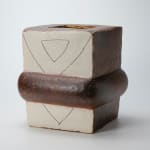Suzuki Osamu 鈴木治 1926-2001
26.7 x 26.7 x 26.7 cm
Further images
-
(View a larger image of thumbnail 1
)

-
(View a larger image of thumbnail 2
)

-
(View a larger image of thumbnail 3
)

-
(View a larger image of thumbnail 4
)

-
(View a larger image of thumbnail 5
)

-
(View a larger image of thumbnail 6
)

-
(View a larger image of thumbnail 7
)

-
(View a larger image of thumbnail 8
)

-
(View a larger image of thumbnail 9
)

-
(View a larger image of thumbnail 10
)

-
(View a larger image of thumbnail 11
)

-
(View a larger image of thumbnail 12
)

-
(View a larger image of thumbnail 13
)

As a co-founder of the avant-garde group Sodeisha (走泥社) in the 1940s, Suzuki Osamu (鈴木治) was integral to the modernization of Japanese art after World War II. He and his peers were among the earlier ones to create ceramic sculptures that functioned solely as aesthetic objects rather than functional items, a direction the general Japanese public found quite shocking. This early piece, executed in 1960's shows the sculptural drive in Suzuki's work. Rather than calling it a jar (壷) Suzuki instead titled this work Vessel (器) thereby formally declaring his sculptural intentions. Taking the general cube shape of much of his work, this piece is formed from the artist's signature red Shigaraki clay. One face of the cube has been painted in flat white slip, and then incised with triangle patterning that reveals the dark clay underneath. Suzuki admired the terra-cotta work of Isamu Noguchi as well as the work of other international artists, finding in both of these sources a respect for material that he brought to his own practice. This piece brings to mind Romanian sculptor Constantin Brancusi's famous The Kiss, in which two abstracted, cube-like figures embrace to form a single cubic mass. Suzuki pushes this work further towards abstraction, into the realm of geometry and minimalist purity. One of the most widely respected potters of the late twentieth century, Suzuki enjoyed a long, prolific, and innovative career. His work can be found in numerous private and public collections, and the National Museum of Modern Art, Kyoto organized a large retrospective of his work in 2013.
- X
- Tumblr













